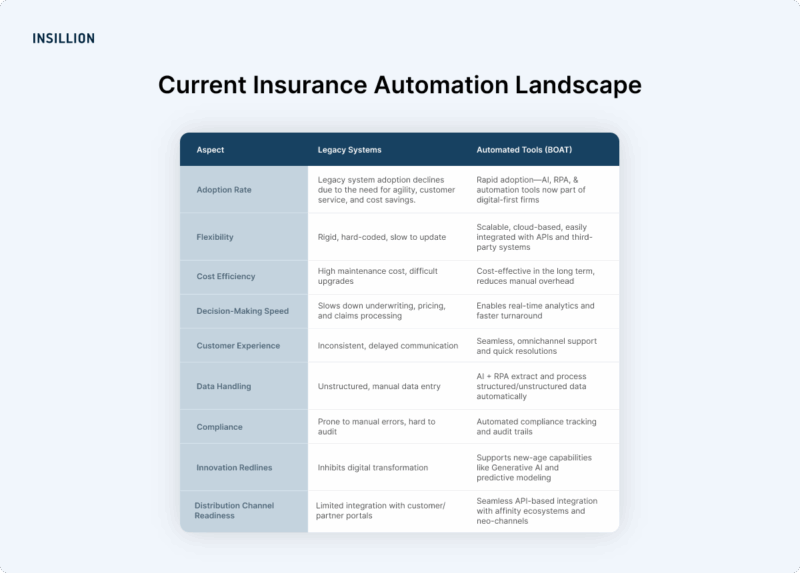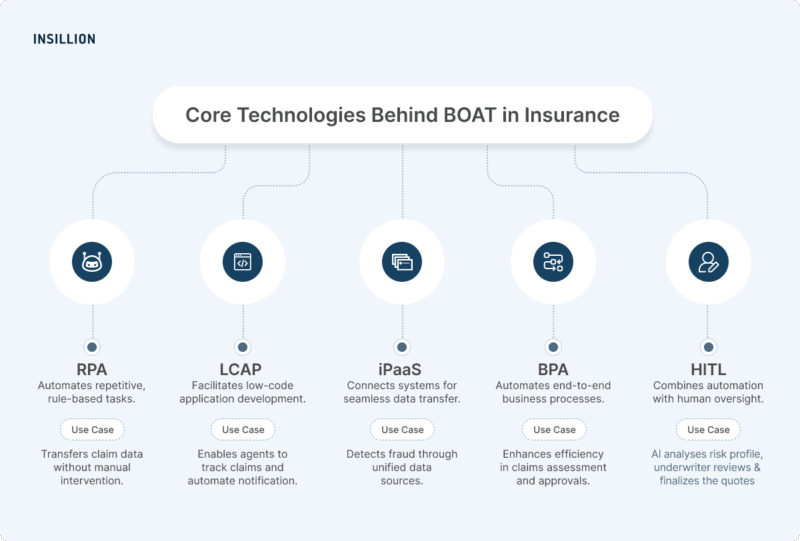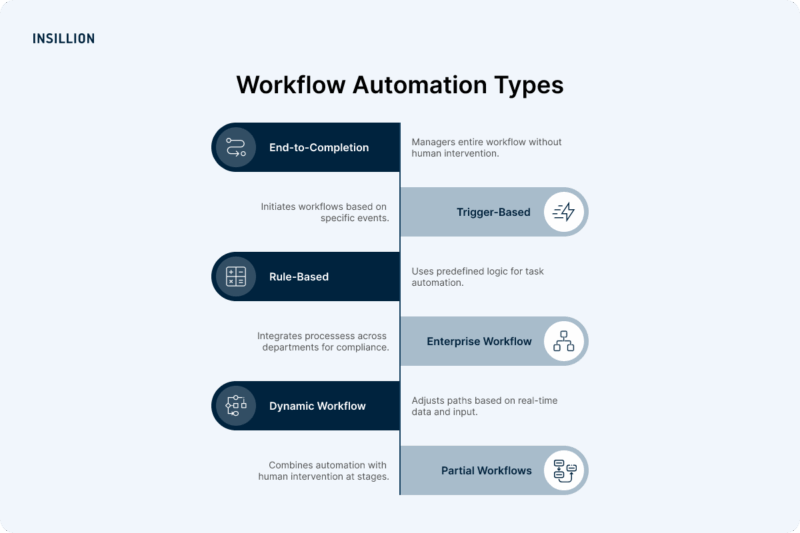Table of Contents
Introduction
As of 2025, insurers are adopting intelligent technologies to transform existing systems and meet rising customer expectations. Business Orchestration and Automation Technologies—combines AI, RPA, and data-driven insights to drive innovation across core processes like underwriting, claims, and customer onboarding. Insurance workflow automation enables real-time agility and faster service.
This blog outlines how carriers/MGAs can use BOAT to revolutionize the insurance process and future-proof their organizations.
Understanding BOAT: What It Really Means
Business Orchestration and Automation Technologies (BOAT) represent a powerful shift in how organizations—especially in the insurance automation space—manage and optimize operations. BOAT is not just about automating individual tasks; it’s about orchestrating entire business ecosystems for seamless, end-to-end performance.
Driven by technologies like Robotic Process Automation (RPA), Artificial Intelligence (AI), workflow automation, and low-code platforms, BOAT offers insurers a unified solution to transform existing systems. With BOAT, RPA in insurance can go beyond basic automation. By integrating document handling, task mining, predictive analytics, and cross-system coordination, insurance workflow automation becomes smarter and more efficient. Insurance workflow automation powered by BOAT, for instance, connects each step in underwriting, from receiving submission details to finally delivering a quote, eliminating delays.
BOAT ensures that every part of the insurance value chain—from data intake to policy issuance—runs in harmony.
Why Automation and Orchestration Matter in Insurance
Insurance automation and orchestration are revolutionizing the insurance industry by streamlining tasks like claims processing and ensuring seamless coordination across underwriting, customer service, and compliance. This combination boosts speed, accuracy, and agility. Insurers can deliver more efficient and responsive insurance services with process orchestration. Insurers can either fully outsource orchestration or integrate specific elements into existing systems.
Current Insurance Automation Landscape
The insurance industry is embracing insurance automation through tools like Robotic Process Automation (RPA), Artificial Intelligence (AI), and workflow engines to improve efficiency and accuracy. Many insurers continue to depend on legacy systems for core processes like pricing and underwriting. The demand for real-time experiences, omnichannel customer support, and seamless partner collaboration has highlighted the limitations of these robust yet rigid platforms. To stay competitive, insurers are expanding their distribution channels and working with broader ecosystem partners.
Yet legacy systems struggle to scale, especially in light of modern needs like API connectivity and integration. Recently, many of the newer automation solutions can work with existing systems, allowing carriers to modernize immediately. This is where Business Orchestration and Automation Technologies (BOAT) offer a long-term, scalable solution. BOAT addresses this gap by integrating RPA, AI, APIs, low-code platforms, and cloud solutions. BOAT enables end-to-end insurance workflow automation, streamlining claims, underwriting, and policy servicing. Digital transformation is central to BOAT adoption, allowing insurers to become more agile, reduce manual tasks, and meet evolving regulatory and customer demands effectively.

Core Technologies Behind BOAT in Insurance
BOAT, a smarter automation solution for the insurance industry, aims to adapt automation tools to business goals rather than adjusting to them.
BOAT = Smarter Automation for Insurance Industry Needs
- RPA (Robotic Process Automation): RPA automates repetitive tasks, reducing human intervention. BOAT integrates these tasks into bigger business processes, making everything work together more smoothly and efficiently. For example, an RPA bot can automatically transfer a customer's claim data from an existing system to a new one without human intervention.
- LCAP (Low-Code Application Platforms): These platforms allow non-technical users to manage rating logic in Excel files and convert them into low-code applications or portals. For example, non-developers (like actuaries or pricing teams) can define premiums and coverage logic without writing code, enabling faster updates, better scalability, and easier deployment across teams or partner systems
- iPaaS (Integration Platform as a Service): Insurance carriers typically rely on a combination of in-house core systems and line-of-business (LOB) specific policy administration platforms to manage critical functions such as policy servicing, claims processing, and customer support. iPaaS connects these and moves data, automating workflows like fraud checks for high-value claims. Combining RPA with iPaaS streamlines repetitive tasks and ensures smooth data flow across systems.
- BPA (Business Process Automation): BPA focuses on end-to-end processes. For instance, insurers can automate the entire claims journey, from verifying documents and assessing damage to approving claims and issuing payments. It combines RPA, LCAP, and iPaaS for smooth operations.
- Human-in-the-Loop (HITL): HITL is a system that integrates human involvement into automated processes, ensuring accuracy and ethical compliance. While automation is advancing, in some underwriting scenarios where complex variables, ethical nuances, or industry-specific insights come into play, a collaborative approach becomes essential. A human underwriter reviews and finalizes it—ensuring accuracy and accountability.

End-to-completion and other types of workflow automation
- End-to-End Workflow Automation manages the entire process from the initial trigger to the outcome without human involvement. It is often used to automate the complete lifecycle of claims, underwriting, and policy issuance.
- Trigger-Based/Event-Driven Automation responds to specific events and initiates workflows based on events like claim filings or fraud alerts. It is often cloud-based, integrated with APIs, and third-party tools enable real-time responsiveness—making insurance workflow automation more agile and customer-centric.
- Rule-based Automation automates tasks like premium calculation and eligibility checks but requires manual updates. Insurance automation platforms offer an underwriter workbench (UWB) that allows for low-code/no-code environments. This allows users to modify workflows and logic visually without heavy IT involvement, such as changing eligibility rules (like age) for specific health plans.
- Enterprise Workflow Automation integrates processes across departments, enhancing compliance and scalability in insurance operations (policy administration, compliance, and CRM). It is often cloud-enabled, especially in digital-first insurance firms.
- Dynamic Workflows: These workflows adjust their path based on real-time data, user input, or process outcomes— perfect for policy renewals and complex approvals. For example, an agentic AI workflow offers intelligence and adaptability. This can be cloud-based, especially when using modern orchestration tools.
- Partial/Assisted Workflows combine automation with human intervention at specific stages. In insurance underwriting, AI may auto-analyze a customer’s risk profile, but an underwriter reviews and finalizes the decision. It can be cloud-based but is often hybrid (a mix of on-premises and cloud); platforms.

Conclusion
In the insurance industry, Business Orchestration and Automation Technologies (BOAT) are revolutionizing operations. BOAT enables insurers to streamline operations, enhance efficiency, and reduce manual errors. This comprehensive approach facilitates seamless coordination across disparate systems. BOAT enhances internal processes and boosts customer satisfaction, making it an essential component for enterprise operations in the insurance industry. As insurance automation continues to evolve, now is the time to future-proof your processes.
Ready to automate smarter?
Let Inflow, a process automation platform, helps you automate and speed up submissions and FNOL using AI-powered data extraction.
Articles
Recent Articles
Loading recent posts...
Stay updated on
what’s relevant